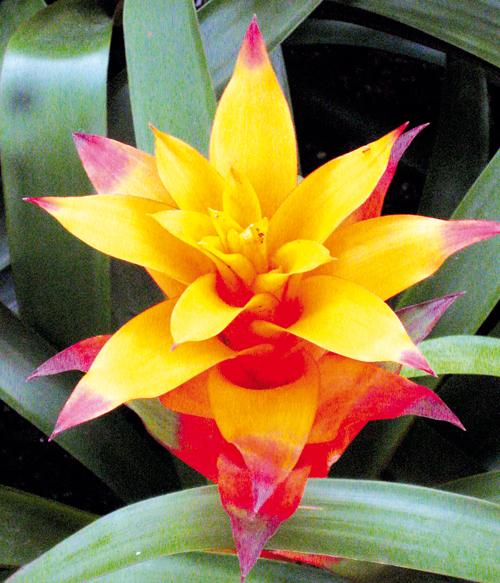Phuket Gardening: Bromeliads offer a true taste of the tropics

PHUKET: I last wrote about bromeliads more than a year ago, but our focus on the letter “B” prompted a re-think. Apart from their deserved popularity as shade and house plants, I have re-focused my attention on this vast genus of more than 3,000 species for other reasons (click here for article).
Recently I visited the Phuket Botanic Garden (click here for article). It has a magnificent collection of bromeliads, some more than a meter high and wide. Mostly planted in containers or sprouting from bark-mulched beds, they sport shades ranging from pale green to deep magenta. If ever a plant deserved a place in the (filtered) sun on account of its foliage, the bromeliad does .
Many of these plants are neoregelias, one of the most widely hybridized. A Thai book on shade plants, which I much value, called Surath Vanno’s Plant Collection, is the product of a lifelong fascination with such plants. It has photographs of no fewer than 19 different neoregelia cultivars, many with picturesque names. They all grow in the author’s nursery. “Tricolor” has striking, curved, leaves which are dramatically banded in green and yellow, “Piccolo” is similar but with pinkish tinges.
Red varieties include “Blushing Bride” and “Grace”, while “Charm” has green mottled foliage which shades to pink at the crown. What amazes me about these assuredly tropical specimens is the appearance of these large rosettes of strap-shaped leaves; they are so glossy they look as though they have been sprayed with clear varnish. Excellent water retention of course.
These neoregelias are not hard to find. Thais, who know them as sapparot find their neat growth and unusual characteristics most appealing. One of my local nurseries has more of these varieties than any other plant. But they are relatively expensive, so you would do well to begin with small potted ones that are suspended, as most of your orchids probably are, above the ground.
Recently I came across another bromeliad in my local Tesco Lotus. I bought one (170 baht) and a customer immediately inquired if it was plastic. It certainly would have passed for a copy. In fact it was real enough with a striking spike of red flowers rising from the crown. The variety? Guzmania. Probably a hybrid called zannli.
Bromeliads are better than most plants at coping with indoor conditions. For a start they are so-called air plants or epiphytes and require little or no feeding. Just give them what they appreciate in the wild – an initial soaking and a few drops of clean water in their cup. Then let them dry out. Make sure they have a well-draining soil base – for example, coconut fiber – some filtered light and relatively high humidity.
They don’t appreciate Stygian gloom or wet feet. Moreover, they won’t last forever indoors – no plant in the tropics will – but mine has managed a month. Soon it will start to turn brown and will need to be taken outside where, hopefully, it will eventually produce small plantlets from the base.
My personal favorite is the aechmea, partly because it was the first bromeliad I encountered. My prized specimen sat imperiously in my London tiled fireplace and attracted many comments from visitors. In those days it was a rarity.
Now they are widely available, a most desirable plant with a distinctive rosy pink spike, so named after the Greek for spear. The curved rosette of long, grey-green leaves, beautifully striped with bands of silver-grey, nicely complements the rosy pink of the aechmea’s flower. It’s probably a bit hot for the aechmea here, but I have seen it flourishing in the shaded area of nurseries. It will naturally do better in the garden – in a shady and well drained spot.
Tip of the week – Pots or beds?
It can be hard to be sure which is best for that new plant – a pot or planting it in a bed? If you are unsure about a shrub’s needs, try growing new acquisitions in different conditions. Put one in a roomy container and another in open ground.
Obviously, you can determine conditions in a pot more readily: for instance, the type of soil, the amount of watering and feeding needed, and the shrub’s position in relation to sun or shade. If potted plants tend to do better, it is because they get more attention.
Nonetheless some shrubs, for instance most climbers and rapid growers with large root systems, do better in beds or borders. Plumerias, hibiscus, bougainvilleas, milkweeds, heliconias, hamelias, ixoras and gardenias are not really at home in containers.
My potted gardenia needs daily watering: it produces masses of buds, but most do not fully open. Slow developers and dwarf varieties generally do better in pots, for example: wrightias, euphorbias and adeniums.
If you have a question, or a garden that you would like featured, you can email Patrick Campbell here.
Keep checking our online Phuket Lifestyle pages, follow us on Twitter @phuketgazette or join our Facebook fan page for regular gardening features and tips.
— Patrick Campbell
Latest Thailand News
Follow The Thaiger on Google News:


























